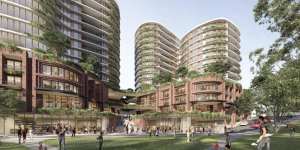But housing is now an official. The NSW government wants to accelerate housing supply. The first stage has been gazetted and will increase density within 400 metres of certain railway stations in Greater Sydney. Thirteen councils are currently affected. And Ku-ring-gai council,where I live,is in the middle of an almighty stoush.

An artist’s impression of a proposed redevelopment in Turramurra,which Ku-ring-gai Council rejected in 2023.Supplied
My family’s home is within 400 metres of one of the four selected railway stations in the LGA. Developers are swarming,our streets face vast and unknown change,and our homes have become ground-zero as we prepare to become the front line of this stand-off. I wonder if our street could become a Legoland of apartments with museum-like heritage listings dwarfed in between.
Let me say up front:I am not opposed,per se,to the state government’s plan to increase density and to build homes around stations. Indeed,within most factions in this debate in Ku-ring-gai,there is agreement that the current housing situation is untenable and solutions are needed. Density near transport makes sense to most people,including me.
So the question is not whether it needs doing. It all revolves around what it means to do it “well”,when it will happen,and how to frame enabling – rather than disabling – processes. I came to Ku-ring-gai as a parent,not as a politician,but these are the processes of representation that have galvanised me to stand as a local independent in the council electionsin September.
The experiences of community that we have come to treasure seem far removed from macroeconomic policies that shape housing supply and demand. As state and federal remits,these policies include tax reform,immigration,zoning,regionalisation,roads,rail. One can assume they have not been effective,as the battleground has moved to local councils expected to accelerate residential growth through density.
Surely,an institution (let’s call it local government) should be stepping in to moderate this with a housing strategy. Residents need certainty about how and where development will be managed so we can make informed decisions.
Critical NSW government policies,for starters,are at risk of being gaily abandoned. The target for the urban tree canopy is an increase to 40 per cent by 2036. Councils cannot meet this unless it is baked into development.
Ku-ring-gai Council’s strategic plan identifies that residents care about community connections,leafiness,and increasing the breadth of local voices heard. In a recent council survey of the Minns proposal,over-45s were over-represented. Apartment dwellers and renters were under-represented.
A mere 25 per cent supported the proposed government housing policies as they stood. However,63 per cent supported or were neutral to increased density near stations. When I spoke independently to residents across ages and backgrounds,over 70 per cent agreed that housing is a collective problem and that increasing density around train stations should progress with proper consideration for tree canopy,infrastructure and heritage.
Do we really want to be a community of seniors? Our area’s demographics show a decline in people,indicating a worrying gap in who can afford to be a local. I heard a deadening resignation from the 18-year-old childcare worker in Gordon when asked about housing density:“I haven’t thought about it. Housing is not accessible to my generation. My sister cannot afford anything. I have accepted I will not be able to live in Sydney.”
And how about integrated housing solutions for our elders? My 83-year-old neighbour reluctantly moved out of the area after more than 40 years on the street. Her grief was palpable over cups of tea in her last weeks on the street,and when she gave me her much-loved pot plants. Engaging the preoccupied or silent majority remains the challenge,all the way to the local bowlo. (My mother had us in stitches at the “bowling whites” requirements of the local club and the delightful,collective,scratching of heads on how this could be achieved by a sari-only-wearing member.)
Meanwhile,in Ku-ring-gai,legal action has commenced against the state government,posters of “Minns’ wrecking ball” decorate poles,and council advertisements about future traffic gridlocks adorn bus shelters. Ku-ring-gai,however,has a particular practice by which all councillors choose to run as independents regardless of party membership. Political strategy can become a little hazy to observers.
A mayoral minute in Ku-ring-gai Council papers says:“The Department[of Planning] had issued a statement claiming that 12 out of 13 councils had collaborated on the TOD SEPP[the government’s plan to create more homes close to transport,jobs and services] – all except Ku-ring-gai. Other councils had been offered deferred commencements ranging from three to 15 months,which for Labor-led councils happens to defer the issue to the other side of the Local Government Elections.”
The politics of opposition,the old red-versus-blue narrative,or “immigrants and foreign investors” against “local heritage and tree canopy”,damages the community. Informed policy and good data would be a more constructive approach to persuasion. And more contact with more locals. You might find them at the bowlo,playing mahjong at the library,at the Persian grocery store,or at the dog park.
Indu Balachandran works in strategy and governance for the social-purpose sector. She lives in Ku-ring-gai and will be running as an independent in the local council elections.